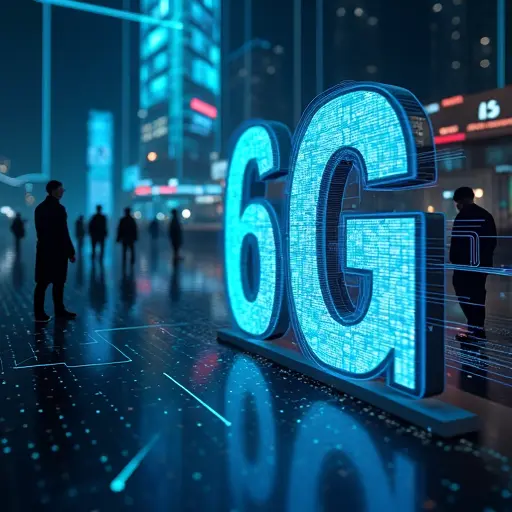6G research accelerates with terahertz breakthroughs and satellite integration. Key 2025 developments include functional terahertz testbeds, China's first 6G test satellite, and AI-native networks. Commercial deployment expected early 2030s.

The Next Wireless Revolution: 6G Takes Shape
As 5G networks become mainstream, researchers and industry leaders are already charting the course for 6G technology, with 2025 marking a pivotal year for foundational breakthroughs. The sixth generation of wireless communication promises to transform how we connect, communicate, and interact with technology through unprecedented speeds, near-instantaneous response times, and seamless integration between terrestrial and satellite networks.
Terahertz Breakthroughs Pave the Way
Recent experiments in terahertz communication are demonstrating the incredible potential of 6G networks. Researchers at SUNY Polytechnic Institute have developed a fully functional experimental terahertz testbed operating in the J-band (220-330 GHz), revealing that terahertz communication channels are inherently asymmetrical with near-field regions extending tens of meters. "These findings fundamentally change how we approach 6G network design," says Dr. Maria Rodriguez, lead researcher at the Wireless and Intelligent Next Generation Systems Center. "The traditional wireless models simply don't apply in the terahertz spectrum."
The terahertz frequency range (0.1-10 THz) represents the next frontier in wireless communications, offering bandwidth capabilities that could enable data rates exceeding 100 Gbps. However, significant challenges remain, including atmospheric absorption, limited transmission range, and hardware implementation difficulties. Major demonstrations in 2025 have included real-time holographic calls and digital twin simulations for smart cities, showcasing the practical applications of these ultra-high-speed connections.
Satellite Integration: The Global Connectivity Vision
One of the most ambitious aspects of 6G development involves the seamless integration of terrestrial and satellite networks. China made headlines in 2025 by launching the first dedicated 6G test satellite, marking a significant milestone in the race toward global, space-based connectivity. "The future of connectivity isn't just about faster phones—it's about creating a truly global network that bridges the digital divide," explains telecommunications analyst James Chen from NIST's Communications Technology Laboratory.
The integration of satellite networks with terrestrial infrastructure will enable applications ranging from autonomous shipping and aviation to remote healthcare and disaster response. According to the FCC TAC 6G Working Group Report 2025, this hybrid approach represents a fundamental shift in how we conceptualize wireless networks, moving beyond traditional cellular coverage to create a truly ubiquitous connectivity fabric.
Timeline and Roadmap Expectations
The standardization timeline for 6G is becoming increasingly clear, with major milestones expected throughout the late 2020s. According to Ericsson's roadmap, initial 6G specifications are expected from 3GPP around 2028-2029, with commercial deployment anticipated in the early 2030s. The NIST Communications Technology Laboratory has developed a strategic 6G roadmap guiding research investments over the next 5-7 years, focusing on critical areas including integrated sensing and communication, AI-native networks, and spectrum management.
"We're not just building faster networks—we're creating intelligent systems that can predict and adapt to user needs," says Dr. Sarah Johnson, a 6G researcher at MIT. "The AI-native approach means networks will become self-healing, self-optimizing entities that can prevent congestion and security threats autonomously."
Global Competition and Use Case Development
The race for 6G leadership is intensifying globally, with the United States, China, South Korea, Japan, and the European Union all making significant investments. The European Hexa-X II project and similar initiatives are exploring use cases that span from autonomous driving and remote robotic surgery to holographic extended reality experiences and quantum-secure defense communications.
Key performance targets for 6G include speeds up to 1 Tbps (compared to 5G's 10 Gbps), latency under 100 microseconds, and quantum-resistant security. These capabilities will enable applications that are currently science fiction, such as real-time holographic communication, immersive virtual environments, and autonomous systems that require instantaneous decision-making.
As the ITU-R IMT-2030 framework continues to evolve, researchers are emphasizing that 6G development should focus on demonstrable user needs rather than simply replacing existing 5G infrastructure. The cautious approach reflects lessons learned from 5G deployment, where revenue growth has been slower than initially predicted.
The journey toward 6G represents one of the most ambitious technological undertakings of our time, promising to redefine connectivity and enable applications that will transform industries, healthcare, education, and daily life. While commercial deployment remains several years away, the breakthroughs of 2025 are laying the foundation for a connected future that will be faster, smarter, and more integrated than ever before.

 Nederlands
Nederlands
 English
English









